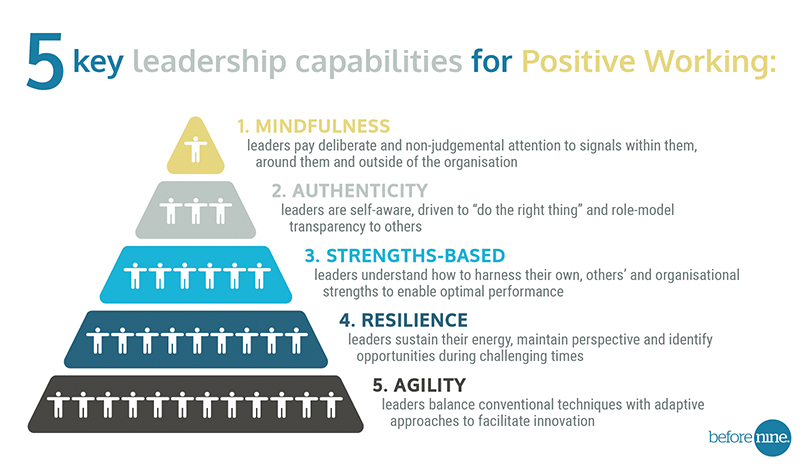A strengths-based approach to neurodiversity
How can organisations bring out the best in their neurodivergent colleagues? Here's our take on how Positive Psychology can help....

Recently, I have seen a recurring theme in my speaking engagements. Many organisations are focused on one key transformation question. I’m talking about the move to hybrid working – also known as blended working. If you’re in a leadership role, I hope this article will help you to reflect on the challenges and opportunities you may face in this area, in particular:
Remote working during the 2020 pandemic started as an emergency response. In 2021, it is firmly out of the starting blocks as a pro-active strategy. Depending on your outlook, it’s a change that can create the conditions for increased diversity, innovation, employee engagement and (if done right) optimal working for positive outcomes.

The ‘what, why and who’ behind that change depends very much on the leadership outlook. Yes, four in five companies expect to continue hybrid working post-lockdown. And some are really putting their heads above the parapet, with the likes of Spotify unveiling a work from anywhere policy for all staff. They’re not, by any means, alone. Facebook, Nationwide and Siemens are just a few of the business heavyweights committing to a permanent homeworking or hybrid model.
It’s not to everyone’s tastes though, with some high profile corporates objecting very publicly to the trend. The collective jury is far from in, but one thing’s for sure: the days of non-negotiable nine to five sat at a bank of desks seem numbered, especially when the workforce are now prepared to walk with their feet if denied the opportunity for flexibility.
For many, a long-term move to hybrid working is still in its trial stages. Personally, I see this as an energising time. Enforced home working during lockdown blurred work/life boundaries and brought into question the lack of a level playing field in terms of how well set up employees are to work from home. Employee experience has not been consistent. But, for those leaders brave enough, experimenting with hybrid working is a new opportunity. It’s a chance to regroup, reconsider future strategy, and perhaps re-invent not just how we work but how we measure success. From a cultural perspective, this experimentation is also a way to strengthen the leadership and workforce agility muscles that are so necessary for business innovation and organisational resilience generally.
Like any transformation initiative, this starts at the top. In my next blog, I’ll look at the managerial challenges of moving to blended working. Here, though, I’m coming at things from a Positive Leadership perspective. The questions on my mind are:
“What does a positive leader need to do to drive the change successfully?”
“How do we quantify success?”
“How do we build a positive hybrid organisation that delivers optimal performance for the business, its staff, and its customers?”

Naturally, there are practical considerations involved in figuring out how hybrid working will look for everyone involved. The ‘big four’ (no, not that one!) must be considered to ensure optimal outcomes. By the big four, I mean the operational cornerstones of safety, space, people, and technology – prime considerations in moving a workforce from a crisis situation to a brand-new professional future. In reality, the change won’t come all at once. Typically, there will be three phases – transition, review, and consolidation of what’s working (and, indeed, what isn’t - let’s remember that Positive Working involves harnessing the positive and learning from the negative).
Make no mistake, this is a meaty piece of work! Faint heart, I find, never wins remarkable results – but positive leadership that role models the right behaviours and messages very much can.
First up: a modified mindset that celebrates the outcome, not the journey. Hybrid working won’t flourish in an atmosphere of suspicion. The response to pandemic home working has highlighted some interesting anomalies between organisational cultures. Some companies have embraced their staff’s ability to adapt, evolve, and find ways to ‘get things done’ in new, efficient ways. Others have imposed heavier governance (endless check-in meetings, anyone?) in the hope of maintaining accountability. For me, it’s how we define that accountability that is crucial. Is it Jim’s timesheet that’s important – or the results he achieves? If Jill takes a flexi-afternoon to support her child’s home learning, but still delivers an optimal outcome, which matters more to the business? In Positive Working, the outcome is the clear measurable. How that outcome is delivered depends on people, organisation and systems working together in a strengths-based way that enables optimal performance.
Second: self-enquiry. Positive leadership depends on authenticity, strengths, resilience, mindfulness and agility. Whether you articulate it or not (and positive leaders very much do), these are qualities that you are role modelling every day to every person in your organisational care. I use the word ‘care’ deliberately, since nurturing culture and strengths creates a workplace where people flourish through learning, values, and resilience. Positive role modelling depends first on recognising your own motivation. For instance, ask yourself, do you really need your people on site every day because you fear they can’t work productively elsewhere? Or are you subconsciously worried that if they are not physically there, they can’t serve your needs? Recognising our own bias, judgements and assumptions are key here. Implementing a positive transformation involves clearly articulating the vision, mission and journey and ensuring those messages cascade to everyone. You cannot give that authentic message to others if you are not being straight with yourself.
And then…inclusivity. For hybrid working to foster creativity, agility, and ultimately success, you need to be in the business of understanding your people. Post-lockdown, the return to work might be cause for celebration, fear, or a million feelings in-between. All are natural, acceptable, and valid. As a positive leader, you must understand and appreciate your people’s motivations, strengths, challenges, and allow that intelligence to drive how you navigate this landscape. This involves a coaching style of leadership, where open consultation and a safe environment facilitate mutual understanding. Be the leader that acknowledges we won't get this right immediately, that it will be a messy experimentation phase (what other kind is there?), and that you don't have all the answers yourself. Just as you need to be the role model for the change, your people need permission to advocate for the conditions that enable them to be their best. Understanding that equips you to piece the puzzle together and work out how hybrid working could deliver for you, your people, and your organisation.

To get started, here are four guiding principles for leading such a significant transformation:
Conviction: Not every organisation or role is suited to hybrid working. It’s important to be clear about why you’re exploring the move – will it create more agility and innovation? Will it support a diverse and motivated workforce? How will it drive better outcomes for the business and deliver on your strategy?
Mindset: If your business is all about timesheets and monitoring MS Teams status, hybrid working will fall flat on its face. As a leader, do you have the courage to commit to an approach that measures success by quantitative and qualitative results, and the achievement of objectives, not the presence of labour?
Role modelling: Are you, and your behaviour, relaying an authentic message to your senior managers, team leaders and people? See my next blog in this series to understand the management perspective and how to support that.
Organisational Values: If you’re not clear on what these are already, you have another piece of work to do! If, however, you are, then mapping how hybrid working might support your culture and values is an important piece of the puzzle.
If you’re interested in developing your positive leadership style to support hybrid working and other transformation programmes, before nine can help. Why not talk to us to take the first steps along the journey?